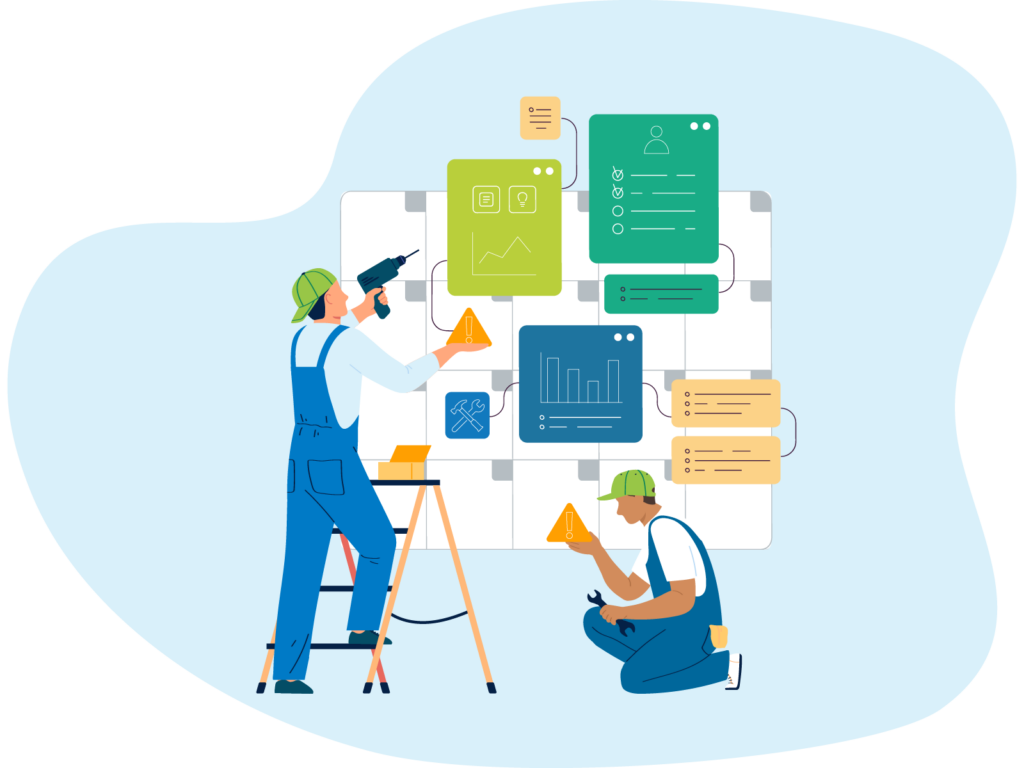What is the difference between CAFM and CMMS?
Discover the differences between CAFM and CMMS systems to ensure you select the right solution for your needs.
Navigating the world of facilities management software can be confusing, not least because of all the acronyms you encounter along the way. This can make it hard to decipher the differences between the various systems out there, and to determine the right solution for your requirements.
Here, we will clear the air between two of the most prominent acronyms in this landscape: CAFM (Computer Aided Facilities Management) and CMMS (Computerised Maintenance Management System).
While some people consider these terms interchangeable, there are actually key differences in terms of scope and application that are crucial to know before you commit to a system. This clear, concise guide will help you understand those changes so you know exactly what to look for from your FM solution.
What is CAFM?
CAFM is the term for technology designed to help users manage the various assets, tools and processes that affect business continuity
CAFM systems are designed to help users manage the assets, tools and processes that maintain business continuity. These comprehensive solutions contain a vast assortment of modules that meet the far-reaching demands of today’s FM professionals, including:
- Property management
- Space management
- Real estate and leasing
- Asset management
- Maintenance planning
- Workflow management
- User wellbeing
- Energy and sustainability
These are just scratching the surface of what the most sophisticated examples of these systems, like MRI Evolution, the most complete CAFM software in the UK and worldwide, can deliver for FMs to help connect and control their buildings like never before.
What is CMMS?
Rather than an all-encompassing approach, a CMMS system hones in on one particular facet of facilities management: maintenance. CMMS focuses solely on managing maintenance requests throughout a facility, from delegating tasks to relevant engineers to monitoring the status of each job up to completion.
The best versions of CMMS software will include many maintenance-focused features, such as:
- Resource and labour management
- Asset classifications
- Workflow management
- Planned preventative maintenance (PPM)
- Inventory management
- Reporting and analysis
These and other modules are designed to deliver complete control of maintenance operations throughout facilities, whether it’s changing a burnt-out lightbulb or repairing a broken generator.
What are the benefits of a CMMS?
The benefits that a CMMS offers as a completely maintenance-focused solution include:
- Enhanced asset visibility
- Greater automation
- Streamlined processes and workflows
- Improved workforce management
- Consistency and knowledge sharing
- Better health and safety
- Stronger compliance management
However, as we will discuss in the next segment, all of these benefits can be found within a CAFM solution with specific maintenance-based modules.
CAFM vs CMMS
So, the prevailing difference between CAFM and CMMS systems is a matter of scope. A CAFM system’s capabilities are significantly wider-reaching than a CMMS, which stays firmly focused on just maintenance-related requirements.
For this reason, it isn’t uncommon for robust CAFM systems to contain a CMMS, or at least all of the capabilities of a CMMS system, within it. MRI Evolution’s maintenance modules for instance:
- Enable users to identify, classify and manage assets in distinct, standardised ways, far faster and more accurately than manual methods
- Organise engineers’ day-to-day routines with clearly planned maintenance works
- Help extend the lifecycles of assets through effective PPMs and ensure all compliance requirements are met
- Offer complete visibility over stock levels and automate the requisition of restocks
- Manage quotes, purchase orders and subcontractors with total ease
- Track and analyse the profitability of maintenance work and present this in easy-to-digest reports and Digital Dashboards
Several market-leading CMMS solutions offer the same or similar functions. However, that is where their capabilities end. Meanwhile, a CAFM system will offer even more to fulfil the needs of FM professionals, be it maximising how space is used throughout a building, capturing key property-related performance data, or keeping energy consumption levels in check.
Fundamentally, a strong CAFM system delivers everything a CMMS system can and much more on top of this. It is the more extensive solution, and more suited to meeting all of the responsibilities that FMs are now expected to fulfil.
So why would you potentially choose a CMMS over a CAFM solution? Well, it then becomes a question of what you need.
If your sole interest is a system that manages maintenance throughout your facilities – whether it’s restocking office supplies, fixing a faulty computer, or plugging a leaky tap – then a CMMS fits this role perfectly.
Should your request tickets from employees or residents go directly to your maintenance or office manager, a CMMS may be all you need to manage them. This is often a more cost-efficient approach for these departments – if you don’t need the wider capabilities of a CAFM system at this time, a CMMS can do the job.
However, it is important to recognise that in return for this lower cost you sacrifice a more comprehensive package. So we’d recommend thinking carefully about whether a maintenance management solution is all you’re seeking, or whether you would receive greater long-term benefits from a more all-inclusive CAFM system…
CMMS vs EAM
Another system that CMMS often gets conflated with is EAM (Enterprise Asset Management). EAM solutions evolved out of CMMS, and is typically more in-depth, particularly in relation to asset management.
An EAM focuses on equipment management, tracking assets’ lifecycles from installation through to replacement, and the processes required at each phase of the process. These databases often include more business functions and information, such as materials, procurement and accounting details.
This collection of data an EAM provides can offer a lot of assistance to maintenance managers in how they maximise the lifespan of assets, but usually at a greater cost than a standard CMMS solution.
Therefore, a CMMS is better suited to manage a single location, while an EAM’s more extensive features are more capable of managing multiple sites and businesses.
Again, however, both still fall short of the overarching capabilities of a substantial CAFM system.
Discover MRI Evolution – the complete CAFM solution
We hope this has given you greater clarity over the differences between a CAFM system and a CMMS system. As we noted, a CMMS solution is perfectly suited to manage any purely maintenance-focused issue you are facing in your organisation – it is specifically designed to meet those challenges directly.
However, for a total building management solution, that not only helps you take ownership of maintenance matters but extends this across the entire facilities management spectrum, a CAFM/IWMS system like MRI Evolution is the right choice.
The hub for every aspect of your business, MRI Evolution’s future-proofed software brings your teams, data and processes into one central, easy-to-use solution, empowering you to direct the FM functions at the core of your organisation faster and smarter.
Whether it is asset management and maintenance requirements, or capturing the abundance of property-related data your facilities generate to guide better business planning, MRI Evolution is the ultimate answer for all requirements.
For more information about MRI Evolution or the complete capabilities of CAFM, get in touch with our team today.
Leading solutions for property occupiers, owners and service providers & contractors.Facilities Management software

Discover the key trends and challenges impacting facility managers
From the adoption of new technologies to the need to adapt practices to suit today’s hybrid working requirements, Facility Managers are being asked to balance numerous responsibilities and priorities. Download our webinar that delves into the ever-ch…

